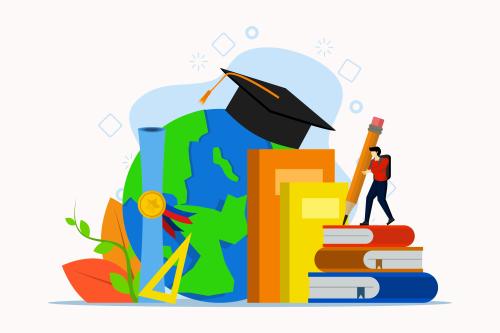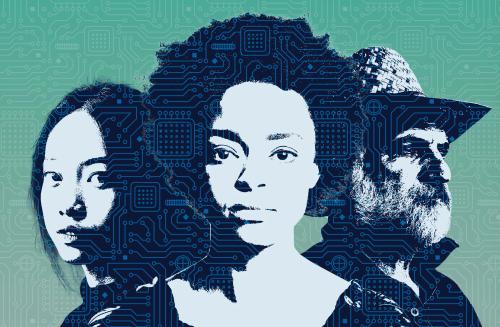Across Latin America, students face significant challenges in reaching basic learning goals—particularly in math and science—often arriving at school with diverse prior knowledge, learning gaps, and home contexts. In this environment, teachers are asked to do the impossible: personalize instruction for 25 or more students in 40-minute classes, often across multiple schools and without sufficient time, tools, or continuity to get to know each learner.
Generative artificial intelligence (AI) offers a new and timely opportunity—not to replace teachers, but to help them better recognize and respond to this classroom heterogeneity. AI tools, when thoughtfully integrated, can support teachers in tailoring explanations, offering adaptive feedback, and scaffolding learning paths that align with the needs of each student.
Our recent study, “Generative AI in Education: A Framework for Leveraging Digital Tools in Latin American Classrooms,” examines how AI-powered tools like chatbots can enhance teachers’ ability to address individual learning needs, especially in under-resourced classrooms where time and pedagogical support are limited. The goal is not simply to assist teachers but to improve student learning by enabling more responsive and equitable instruction, offering scalable solutions to persistent gaps.
From automation to augmentation
Unlike previous waves of educational technology—which focused on delivering content or automating tasks—generative AI introduces dynamic, conversational tools capable of real-time feedback, tailored explanations, and interactive learning.
The first step is reframing how we think about AI in education. For decades, educational technologies have aimed to automate routine tasks or provide access to digital content. Generative AI, by contrast, brings dialogic and adaptive capacities into the classroom: Tools like ChatGPT can answer questions, model reasoning strategies, and scaffold student thinking in ways that mirror effective teaching. For example, a teacher unfamiliar with a programming concept can prompt an AI assistant to generate a simplified explanation for students, along with sample exercises and common misconceptions to address. In the classroom, AI can provide real-time feedback to students as they work through problems—freeing the teacher to focus on students who need extra help.
What makes this powerful is not the sophistication of the tool but its potential to help teachers engage more closely with each student. In classrooms where time is short and diversity is high—different levels, prior gaps, learning speeds—AI can offer a form of “pedagogical bandwidth,” helping teachers detect learning patterns, follow up on errors, and respond to needs that would otherwise go unnoticed.
This evolution opens new possibilities—not to displace teachers but to amplify their reach and pedagogical depth, particularly when human expertise is in short supply due to large class sizes or the accumulated learning gaps students bring from previous years. A well-designed, customized chatbot, for example, can support teachers by generating instructional content, offering real-time explanations during class or responding to student queries outside school hours.
Even relatively simple tools—such as an AI assistant trained on local curricula—can help surface what each student knows, how they reason, and where they struggle. By handling some of the cognitive load, these tools give teachers more space to focus on the things only humans can do, including building trust, interpreting context, mentoring and motivating students, as well as guiding critical thinking. This is not about replacing educators; it’s about expanding their reach.
Why this matters for Latin America
Across Latin America, teachers are often expected to manage classrooms with many students, limited time, and a wide range of learning needs. Even when teachers are well prepared, it is difficult to adapt lessons to each student, follow up on individual progress, or provide personalized support—especially when they work in several schools and have few opportunities for collaboration.
In this context, AI can be a helpful tool. It can support teachers by offering explanations, generating exercises, and giving feedback on student work. These tools do not replace teachers but help them respond more effectively to the different needs they face in the classroom—particularly in subjects like math and science, where learning gaps tend to accumulate over time. The point is not that teachers lack skills but that they often lack the time, tools, or support to fully use them. A chatbot, for example, can suggest different ways to explain a concept or highlight where students are struggling. This allows teachers to focus on guiding learning rather than spending time preparing materials or correcting every task by hand.
Moreover, teachers often lack access to mentoring or peer support—particularly in rural or low-resource settings. In these contexts, AI can also act as a kind of assistant—helping with lesson planning or classroom strategies. While not a replacement for in-person collaboration, these tools can reduce professional isolation and offer ongoing, context-specific support.
Latin America combines urgent educational challenges with a growing digital infrastructure. This makes the region well positioned to explore how AI can support classroom learning in realistic, scalable ways. What we learn here can also be useful for other countries that face similar constraints—whether due to inequality, limited capacity, or growing student diversity.
(Importantly, many of these lessons from Latin America are relevant to other resource-constrained countries, as well as to high-income economies facing a decline in their educational workforce capacity.)
Complementarity, not substitution
Still, AI’s benefits are contingent on how it is integrated into the classroom. Research shows that technical capacity alone is not enough—what matters is the way AI is integrated into teaching. When used passively—as a source of pre-written answers or automatic grading—AI can undermine student effort, reinforcing shallow learning (copying and pasting) and metacognitive laziness (letting AI do the work without trying to understand). But when embedded into a pedagogically sound framework, it can help students stay engaged, learn from mistakes, and explore new ways of thinking.
In classrooms with many students and limited time, teachers often struggle to know what each student understands, where they are stuck, or how they learn best. AI can help fill that gap. It can provide feedback while students work, detect recurring errors, and suggest follow-up activities—all of which make it easier for teachers to support each student in a more targeted way. This is especially useful for students who might otherwise go unnoticed: those who are quiet, who carry gaps from previous years, or who need extra time to process information. In that sense, AI can become a tool for equity—not by treating everyone the same but by helping teachers respond to each learner more personally.
Of course, none of these can work efficiently without the teacher. To make AI a real complement to teaching, teachers need to understand how to use it in ways that fit their subject, their students, and their own teaching style. If AI is treated as an add-on or a shortcut, it can easily become irrelevant—or even harmful.
That’s why we emphasize a phased integration model—starting, for example, by helping teachers plan lessons or generate materials. Only after proper training should student-facing applications be introduced under teacher supervision. This keeps the teacher at the center of the learning process, while allowing AI to expand what is possible in the classroom.
What policymakers should do
To translate this vision into action, policymakers will need to align technology choices with school capacity, teacher needs, and the ultimate goals: teaching and learning. This means designing AI strategies that are context aware, equity oriented, and evidence driven, including:
- Prioritizing teacher-facing AI tools – Focus on using chatbots to support teachers directly—for example, in lesson planning, content generation, and real-time assistance—not just student automation.
- Investing in AI literacy and pedagogical training – Teachers need to understand what AI can (and cannot) do and how to integrate it without losing control of their role. Training should cover tool usage and thinking critically about when and why to use them.
- Aligning AI applications with existing curricular goals – Ideally, AI content should be adapted to match national curricula and instructional objectives. But it is not always necessary—nor, in some cases, realistic—to build a new platform for each subject or each country. With the right training, teachers can learn to use general-purpose tools, like ChatGPT, in effective and responsible ways.
- Piloting before scaling – Structured experimentation—through randomized trials, lighter process evaluations, or sandbox pilots (small-scale, controlled AI deployments)—can help assess what works in different contexts and avoid overpromising or scaling up tools that may not fit local needs.
- Maintaining the human core of education – AI should free teachers to do more of what only humans can: build relationships, foster critical thinking, and support students’ emotional and social development.
- Ensuring digital access – Of course, realizing AI’s potential requires more than smart software. Foundational infrastructure—reliable connectivity, device access, and digital platforms—is essential, especially in rural and low-income areas.
Emerging models: A few examples
Across Latin America and other emerging contexts, a growing number of initiatives are experimenting with AI to enhance human instruction. These experiences offer valuable insights into what responsible, context-aware integration can look like in practice:
Uruguay: Ceibal’s AI-supported coding program
Uruguay’s public edtech platform, Ceibal, is piloting AI-powered tutors in its national computational thinking curriculum. Students interact with coding assistants while teachers retain full pedagogical control. A randomized evaluation is underway to assess its impact on engagement and learning.
Ghana: AI via WhatsApp
In low-connectivity settings, AI has been adapted to work through familiar platforms like WhatsApp. In Ghana, structured AI-supported group chats facilitate collaborative learning and peer interaction without the need for new infrastructure.
India: Adaptive math for low performers
India’s Mindspark platform uses AI to personalize math instruction in real time. Rigorous evaluations found that it helped low-performing students make substantial gains—highlighting AI’s potential to close learning gaps in large, under-resourced classrooms.
Turkey: A cautionary tale on overreliance
A recent evaluation in Turkey found that GPT-4-based AI tutors significantly improved short-term learning outcomes in high school math, but also revealed a “crutch effect”: Students who became overly reliant on the AI tool performed worse after losing access, compared to peers who never used it. This underscores the importance of thoughtful integration and appropriate safeguards to ensure AI remains a complement—not a short-term substitute—for human learning.
More broadly, these cases reinforce an overarching principle: AI works best when it supports teachers, not sidesteps them. Whether through structured pilots or informal experimentation, early adopters are showing how to make AI a complement—not a crutch—in the classroom.
The bottom line
Generative AI will not fix Latin America’s education systems. But it can be part of the solution if we treat it as a tool for complementing human instruction—not automating it. In classrooms where one teacher has 25 students and only 40 minutes per week with each group, it is very difficult to personalize instruction or detect learning gaps early. AI can help by offering support that adapts to each student, making it easier for teachers to focus on the things that matter most.
Ongoing pilots and forthcoming evaluations will provide clearer answers on when, how, and for whom AI tools can most effectively support classroom learning. This is not about replacing teachers or lowering expectations. It is about creating new ways for teachers to connect with their students, even in difficult conditions. In some cases, automation may be a first step—allowing teachers to get familiar with the tools and see how they can be used responsibly. Over time, this can open space for more meaningful uses of AI in the classroom.
Latin America is well positioned to lead in this space, combining urgent need with growing digital capacity. The challenge is to ensure that these tools are deployed not as shortcuts but as scaffolds—reinforcing the human core of teaching and helping every student be seen, supported, and able to learn more effectively, wherever they are.
-
Acknowledgements and disclosures
Meta is a general, unrestricted donor to the Brookings Institution. The findings, interpretations, and conclusions posted in this piece are solely those of the authors and are not influenced by any donations.
The Brookings Institution is committed to quality, independence, and impact.
We are supported by a diverse array of funders. In line with our values and policies, each Brookings publication represents the sole views of its author(s).








Commentary
How AI can support teachers in Latin America
April 11, 2025